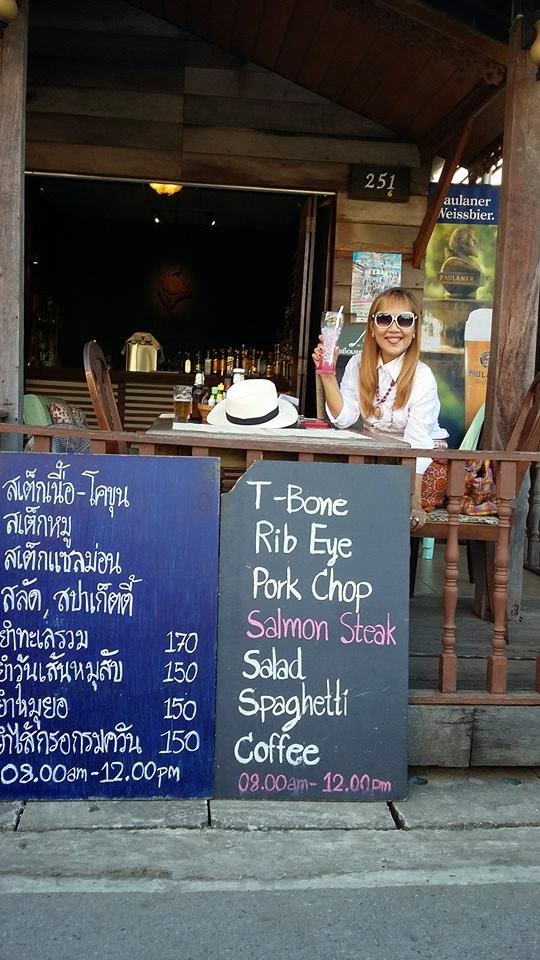The Lao beer is cold and my T Bone steak and a fresh salad is delicious. Across the Mekong river the Lao country side sizzles in the afternoon heat.
Laos is across the river on the upper left of the photo.
This old river trading port in northeast Thailand has become the town that time remembered. Perched on the banks of the Mae Nam Khong (Mekong River), 580 kilometres north of Bangkok, Chiang Khan was until recently an unremarked settlement whose glory days — if any — of the rubber trade, opium smuggling, banditry and cross-river spats with colonial French or communist Laos, were well behind it.
Its original main road, Chai Khong, running parallel with the river, had been superseded by a newer, highway-facing town built just inland. Like a Mekong-moated Brigadoon, Chai Khong Road’s kilometre of century-old, two-storey teak shophouses was slipping into a picturesque decrepitude of subsiding stumps, rust and irrelevance.
And then the Janus-faced joker of tourism stumbled into town. Starting with a trickle of savvy Bangkokians in search of something more authentically Thai than mega-malls and traffic jams, the word spread that here was a piece of Thai heritage that still looked like itself — that hadn’t yet been slam-dunked with T-shirt stalls, night markets and kitsch.
“Yes, the town has much history,” a local woman tells me, “but it is written in Thai. I can read, but have not.”
It’s hard to get many hard facts about Chiang Khan, other than it has a handful of fine, old Buddhist temples; there is, perhaps, a population of around 10,000 people; and the town celebrated its centenary in 2009. Searching, I find a Thai language website that, having run itself through a translator app, describes the town with the sort of fantastic cut-up poetics that William S. Burroughs would applaud, and I can’t beat: “Chiang Khan, the beauty of diamonds coconut long glass, she was as silk to the island and curry source of culture.”
A flautist from southern Thailand tells me he earns a living here for a few months of the year by playing on the river bank.
The restaurant manager points to a concrete building down the road saying “Townspeople took shelter here when there were cannon attacks from Laos across the river because it was the only concrete house in town.” I assume this is probably during the Pathet Lao rule of the late 1960s to early 1970s.
Sensibly, Chiang Khan’s citizens constructed a promenade long ago that runs the length of the old town along the riverbank – a great spot to stroll during lavish sunsets, the burning noon or occasional morning mists. On the river below, fishermen in pirogues net the eternal tides that slip past heading from Tibet to the South China Sea.
From the far bank I can hear Lao music – the zither-like khim or bouncy Isaan jigs — and see kids splashing on sandy river beaches.
Chiang Khan has boomed in the past four years, and even more so in the last two. It has well and truly been ‘discovered’ by urban Thais (although not by farang — I see fewer than a dozen foreigners a day), many of them drawn to a nostalgic past that they never had: Buddhist monks at dawn receiving alms and sticky rice, those rambling family homes made of ancient teak on streets of almost no vehicles, and local specialities like hand-sewn quilts and maphrao kaew (sugar-coated dried coconut) snacks.
What visitors don’t come here for is banana boats, go-go bars, day spas, botox clinics, ladyboys, muay thai boxing, bucket booze and elephant rides – just yet.
Those changes now see the old, meandering, wooden, Mekong-side of Chai Khong Road transformed each evening into an open-air mall of trinket stalls, pirate DVDs and CDs, hawker snack carts and logo T-shirts (I love Chiang Khan, etc.). Quite literally, at times, I can’t see its teakwood for the T’s.
“I am afraid Chiang Khan is going to be the next Pai,” a senior Buddhist monk told an earlier reporter, referring to the once-lovely northern Thailand town that has been overrun by night marketeers, tourists and investors, eviscerating its former essence.
And these shades of Pai, Pattaya and Patong are already appearing along Chai Khong Road too. The irony is that much of the tourist booty for sale here is no longer locally-made but mass-produced wares that visitors can buy in any Thai market from Chiang Mai to Bangkok to Koh Chang — just tweak the last word in the “I love (wherever)” tagline.
Some 619 out of 2317 vintage shophouses on Chai Khong Road and its adjacent alleys have been registered with the municipality’s architectural campaign. What degree of actual ‘protection’ this affords them is unclear.
I had a most enjoyable day in Chiang Khan and went back to quiter Loei where I am staying with friends. I can certainly recommend a visit to the Loei province.






No comments:
Post a Comment